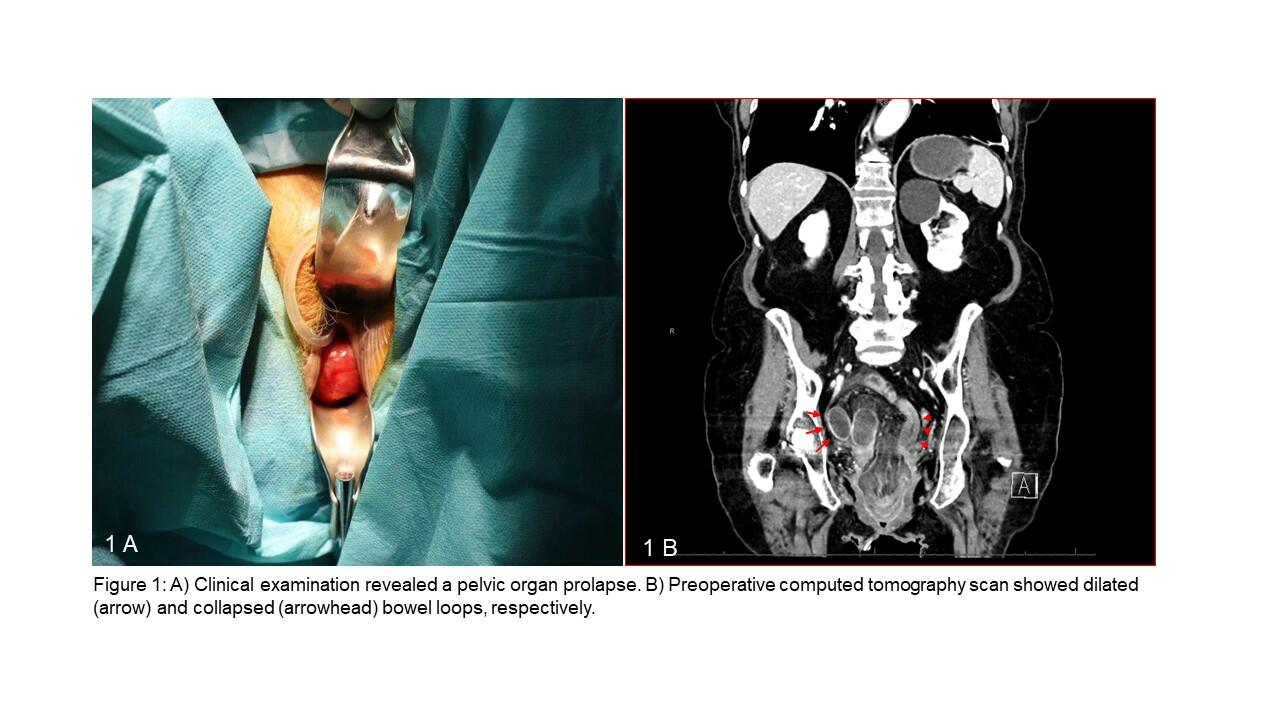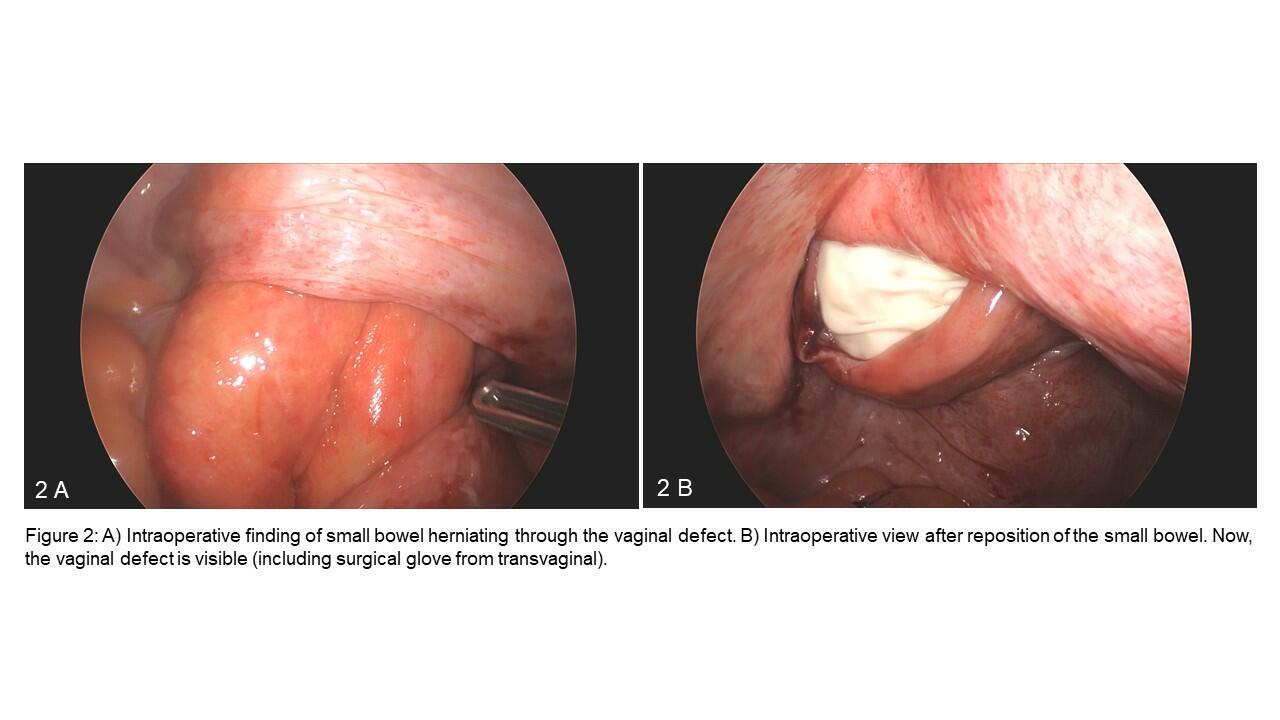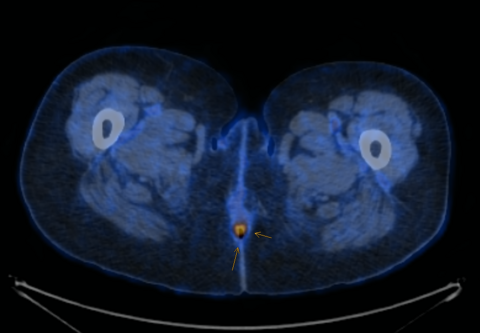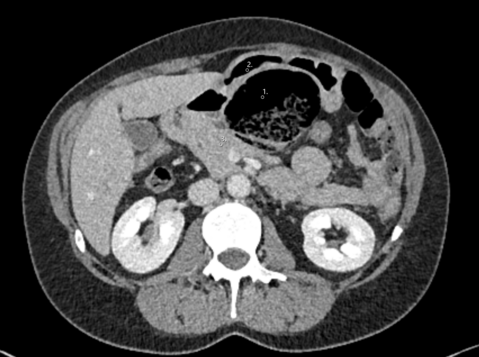Case description
An 89-year-old-woman presented to the emergency department with new onset of pelvic pressure and vaginal prolapse immediately after straining to defecate. Past medical history included hysterectomy for endometrial adenocarcinoma and adjuvant radiotherapy 30 years ago. Clinical examination showed a pelvic organ prolapse with a bulge in the vagina (Figure 1 A).
Manual reduction of the prolapse was not possible due to pain. Apart from the prolapse, clinical examination and laboratory results were unremarkable. The patient was admitted for clinical monitoring. In the further clinical course, the patient developed symptoms of bowel obstruction with vomiting and diffuse abdominal tenderness. C-reactive protein (CRP) increased to 148 mg/l (norm: 5 mg/l). A subsequently performed contrast-enhanced computed tomography scan showed signs of mechanical obstruction of the small bowel (Figure 1 B). In light of the clinical deterioration and tomographic findings, a diagnostic laparoscopy was performed.
Question: What is the most likely intraoperative finding?
A) Adhesive small bowel obstruction
B) Vaginal vault prolapse
C) Volvulus
D) Small bowel evisceration after vaginal cuff rupture
E) Recurrence of the endometrial adenocarcinoma
Case solution
Intraoperatively, small bowel herniating through a defect in the vaginal cuff was found (Figure 2 A/B). The small intestine was manually reduced by gentle intraabdominal traction and transvaginal pressure. The incarcerated small bowel was viable and there was no need for resection. The opening in the vaginal vault was sutured in two layers; the first layer was performed by absorbable interrupted suture, the second layer was done with continuous barbed suture. Postoperative recovery was uneventful and the patient was discharged in good condition.
Acute vaginal vault dehiscence is a rare condition (1). Clinical presentation varies from pelvic pain and vaginal bleeding to evisceration with bowel incarceration – as in the present case. It mainly occurs in postmenopausal females with a history of hysterectomy or vaginal surgery following vaginal trauma or a sudden increase in intra-abdominal pressure (2, 3). As shown in this images in surgery, high degree of suspicion and thorough clinical examination are necessary in patients presenting with acute pelvic organ prolapse, since bowel herniation can be easily overlooked on initial diagnostics and/or be misinterpreted as vaginal vault prolapse. Emergency surgical exploration with prompt reduction of the herniated bowel and reconstruction of the vaginal vault is mandatory to avoid complications such as bowel ischemia, perforation, and sepsis (4, 5)
Reviewed by
Pascal Probst, Editorial Team
1. Nasr AO, Tormey S, Aziz MA, Lane B. Vaginal herniation: case report and review of the literature. Am J Obstet Gynecol. 2005;193(1):95-7.
2. Kowalski LD, Seski JC, Timmins PF, Kanbour AI, Kunschner AJ, Kanbour-Shakir A. Vaginal evisceration: presentation and management in postmenopausal women. J Am Coll Surg. 1996;183(3):225-9.
3. Ramirez PT, Klemer DP. Vaginal evisceration after hysterectomy: a literature review. Obstet Gynecol Surv. 2002;57(7):462-7.
4. Alfraidi R, Abdulaaly N, Alharbi A, Almodhaiberi H, Ali B, Sabagh H. Transvaginal small bowel evisceration: Case report and review of literature. Int J Surg Case Rep. 2022;96:107322.
5. O'Brien LM, Bellin LS, Isenberg GA, Goldstein SD. Spontaneous transvaginal small-bowel evisceration after perineal proctectomy: report of a case and review of the literature. Dis Colon Rectum. 2002;45(5):698-9.















